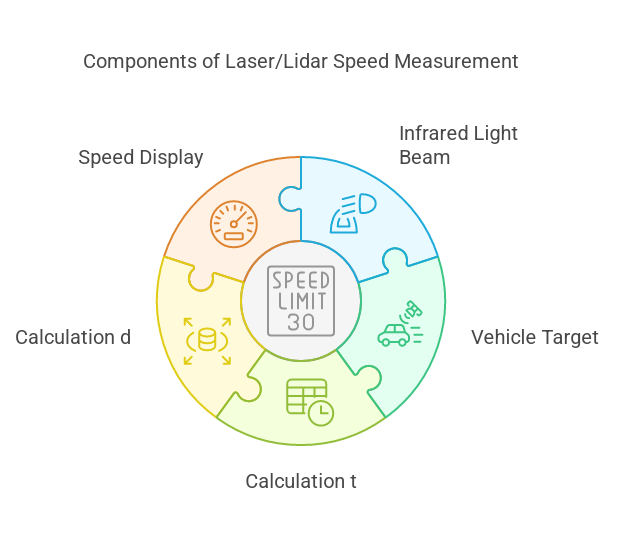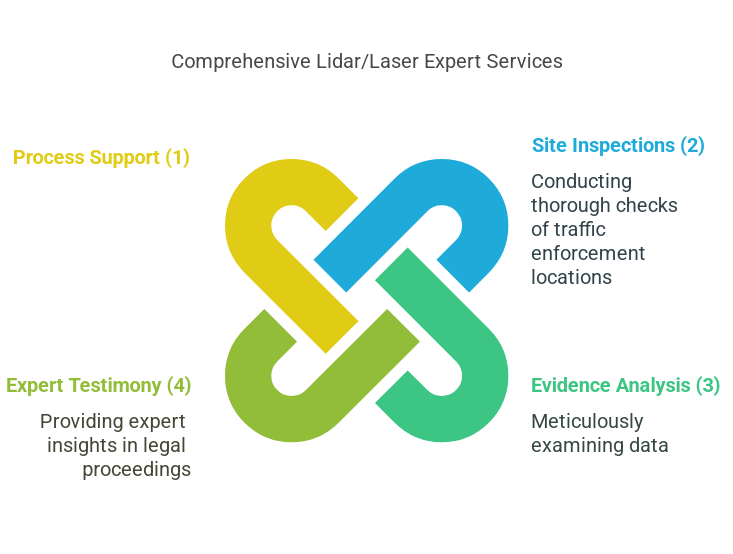Police Laser - Lidar Speeding Ticket Expert
We can help!
The Offices Of Perry J Zucker, Degreed Engineers, are a well-regarded forensic engineering firm with a strong national presence. Since our establishment in 1993, we have consistently demonstrated impressive success and a proactive approach in our field. Our dedicated team comprises of accomplished in-house engineers, technicians, and support staff, who specialize in addressing matters related to police lidar/laser speeding tickets and violations. Specifically, we proficiently handle cases pertaining to probable cause traffic stops and reasonable suspicion traffic stops.
Role and Responsibility of the Expert Witness - Engineer
An engineer expert witness (commonly referred to as an EEW) is an individual who specializes in the field of engineering and provides invaluable assistance to the judicial system, which includes judges, juries, and lawyers, by offering a lucid understanding of the technical complexities within a particular legal case. Their role often involves elucidating the application of scientific principles to specific situations in alignment with relevant laws and regulations. For example, an EEW may provide testimonies regarding the functionality and accuracy of police laser / lidar speed measuring devices, the topography of a particular roadway, and the appropriate utilization of such equipment. It is pertinent to note that all of our conclusions are derived from evidential based data, devoid of any speculative, untrustworthy pseudo-science or junk science.
Here are the key responsibilities of an expert witness in such cases:
- Technical Explanation: The expert witness provides a detailed technical explanation of how speed measuring devices (like lidar/laser) operate.
- Accuracy and Reliability: They testify to the accuracy and reliability of the speed measuring device used in the case.
- Training and Certification: The expert witness outlines their own qualifications, training, and certification in using speed measuring devices. This helps establish their credibility in interpreting and presenting technical data to the court.
- Evidence Interpretation: They interpret the data obtained from the speed measuring device and explain its significance to the court. This includes clarifying how the speed measurement was taken, any relevant environmental conditions, and potential factors that may affect accuracy.
- Cross-Examination: During cross-examination, the expert witness defends their testimony against challenges from the defense. They may also address any discrepancies or alternative interpretations of the technical evidence presented.
Overall, the expert witness serves to educate the court on the technical aspects of the case, ensuring that judges and jurors can make informed decisions based on reliable evidence. Their role is critical in providing clarity and impartiality regarding the technical details of speed measurement in the context of speeding tickets or traffic violation cases.
Fight Your Laser / Lidar Speeding Ticket with Science, Not Just Arguments:
We deliver a comprehensive analysis of complex facts and expert testimony regarding the Lidar / Laser measurement methodology of your speed.
Myth and Reality:
The support of a qualified expert / expert witness provides the technical resources necessary to strengthen your case. We serve as a valuable extension of your legal team, enhancing their overall effectiveness.
Lidar / Laser Speeding - How Police Laser / Lidar Works? - Speed Measuring Device:
Laser / Lidar speed measuring devices used for issuing speeding tickets utilize an infrared light beam with varying beam widths, dependent on the specific laser unit and distance. A police officer activates the unit to measure a moving target (vehicle). The unit emits a series of light beams pulses with a known frequency in the infrared range, averaging the errors of distances. The pulsing beam strikes the target vehicle and reflects back to the unit with a specific time and frequency. By calculating the time difference (dt) and the difference in distance (dd), the laser / lidar unit determines the velocity (v = dd / dt; d: distance). The Greek symbol "dd" represents the difference (X2 - X1). The officer observes the target vehicle (yours / defendant) and reads the digit speed display of the laser / lidar device.

Police Laser / Lidar Challenges:
LIDAR (Light Detection and Ranging), including handheld devices such as laser or lidar guns, consists of a single unit that integrates the antenna, transmitter, and receiver. These devices may encounter various challenges, including operational, readings, errors, trig, and other related concerns.
Accuracy For Police Laser / Lidar - Speed / Distance
Laser / lidar gun speeding devices has NOT been given judicial recognition in all states. However, the accuracy should be within digits.
Errors in Police lidar / laser guns?
Discrepancies in accuracy may occur if the lidar / laser gun is not operated correctly, properly, and/or tested.
Police Lidar / Laser - Standard Operating Procedure:
The officer may conduct a series of test(s) to help the operator assess the functionality of the laser / lidar unit. This assessment will determine whether the unit should be put into full operation or taken out of service.
Operating Distance - Laser / Lidar Gun
Some laser guns have a range exceeding 100 feet.
Methods of Laser / Lidar Set-Up:
Catch and Chase:
The procedure involves a minimum of two police vehicles. Police vehicle one is a stationary vehicle equipped with a lidar/laser speed measuring device, specifically a handheld laser / lidar gun. The operator activates the speed measuring device, directing the laser beam towards the target vehicle. The beam reflects back to the lidar / laser device, and the police officer/state trooper reads the speed displayed on the digital readout, typically LED or LCD. They then communicate this information to a second police officer in vehicle two, who is positioned ahead, using a two-way radio. The pursuing police vehicle initiates a traffic stop on the target vehicle.
Blind Spot:
This procedure entails the use of a parked law enforcement vehicle that may be positioned facing, against, or perpendicular to traffic and the roadway. As soon as a driver notices the presence of the law enforcement officer, the laser beam is already directed at the target vehicle, and a traffic stop is initiated. Watch the video >
How to beat Lidar / Laser Traffic Speeding Ticket - Trial Preparation:
Carefully review all the documents and evidence that the officer intends to present during the trial. This may include data records and other files. Police officers who issue lidar or laser speeding tickets are considered expert witnesses in using these devices, but not necessarily in their theoretical underpinnings. Therefore, the most logical defense strategy would be to engage an expert witness who is an engineer specializing in laser or lidar speed measuring devices. This expert should also possess knowledge in police training, vehicle characteristics, court rules, and hold certifications as a speed measuring device operator and instructor as well as a certified vehicle technician or mechanic. It is worth noting that trial by declaration (mail) is typically not very successful, especially in certain states.
Police Traffic Laser / Lidar Expert Witness
We provide experienced police lidar / laser experts and expert witnesses who specialize in conducting thorough site inspections, analyzing evidence meticulously, and delivering expert testimony on police lidar / laser speeding tickets and probable cause traffic stops. Our experts work diligently to ensure a fair and just legal process in courts across the nation.

